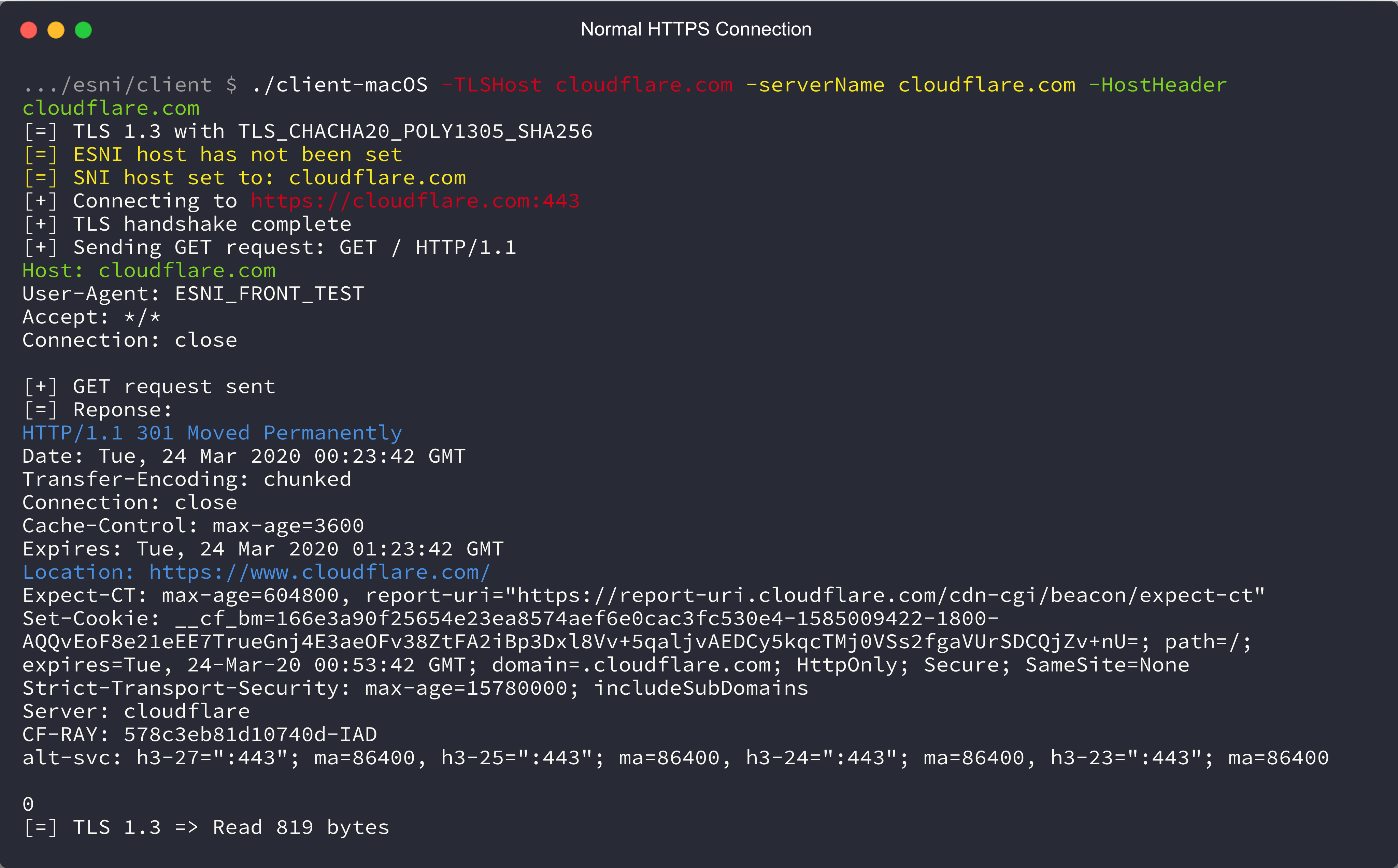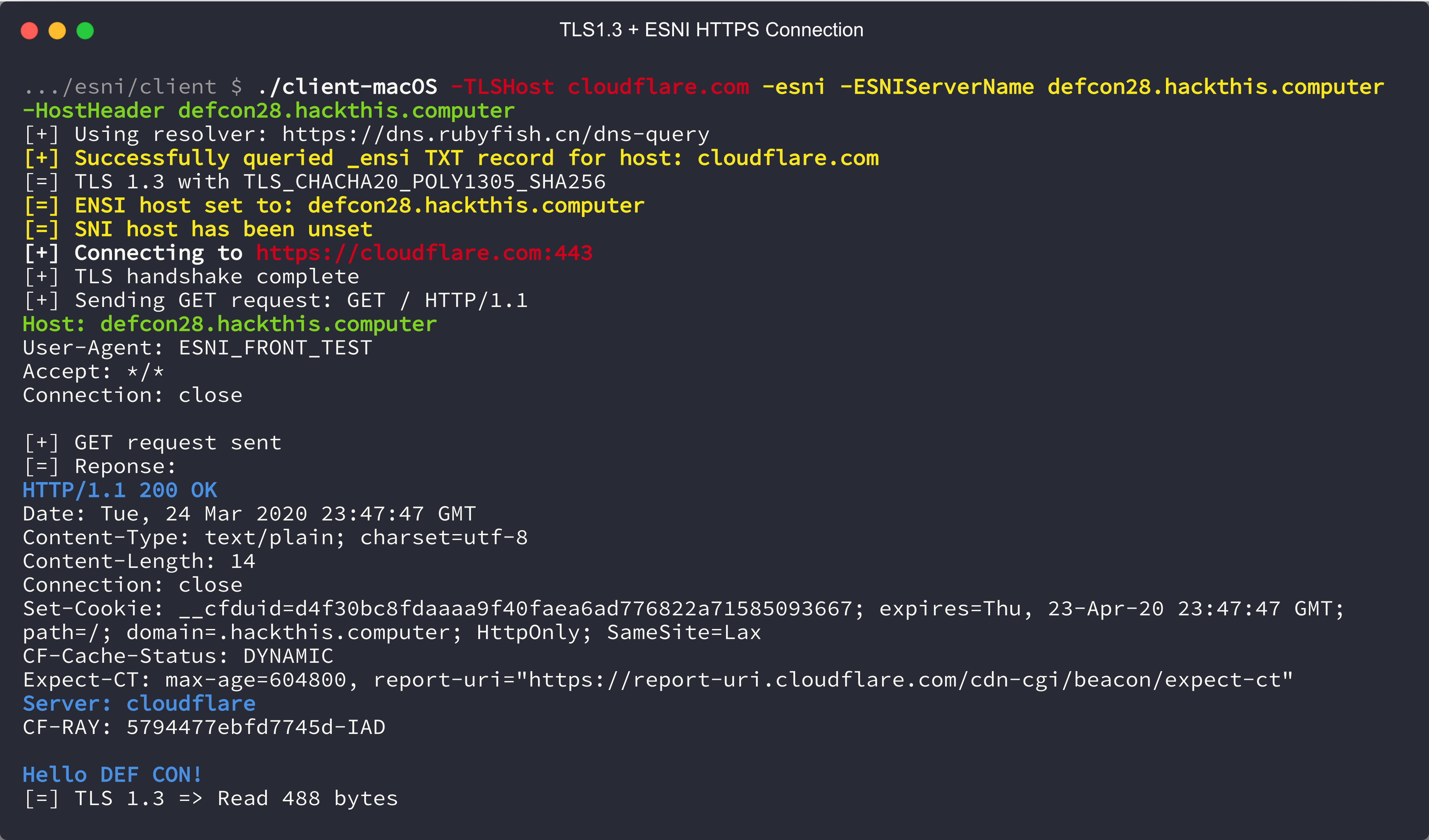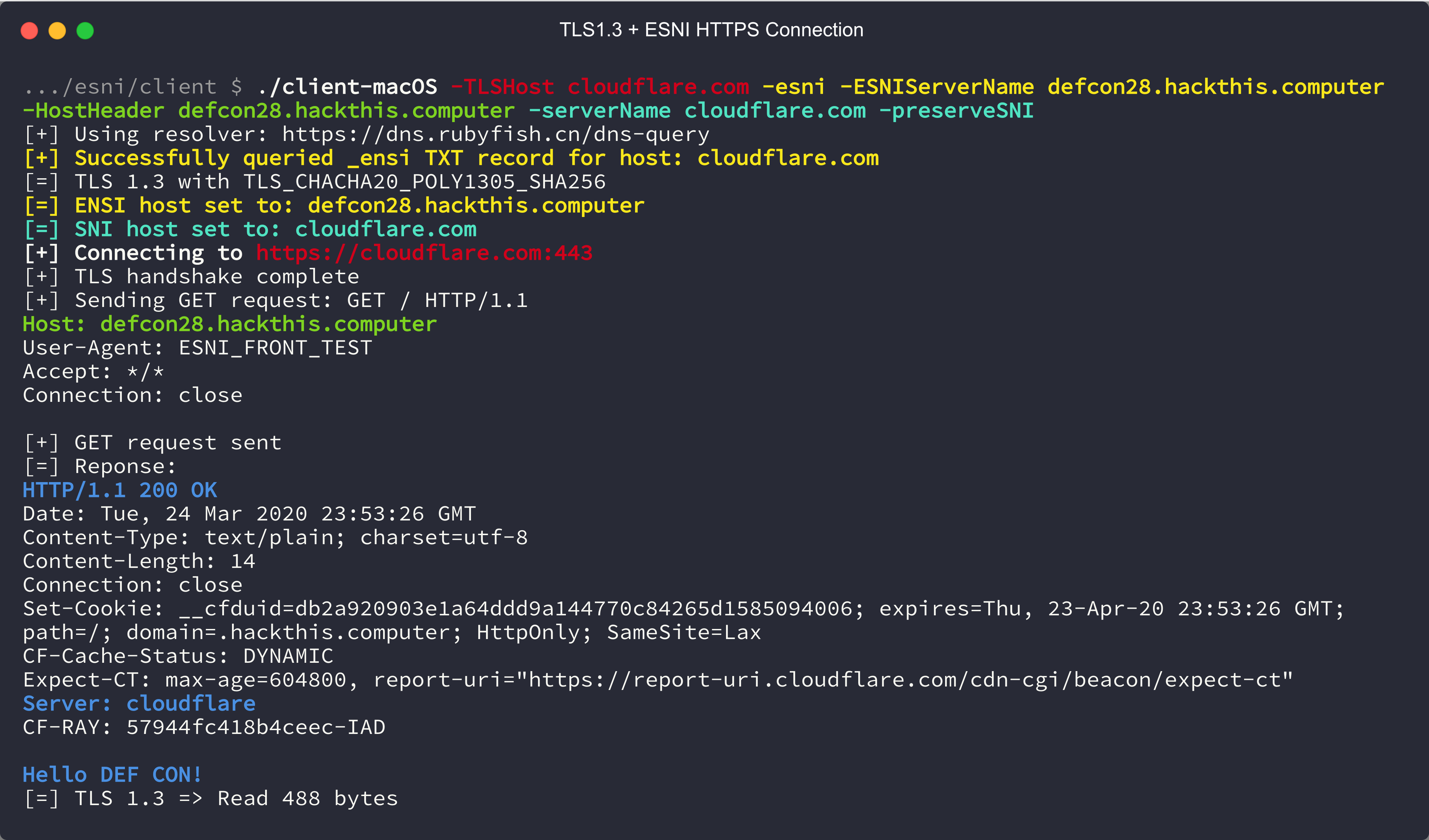Cloudflare is now refusing any ClientHello with an ESNI and an SNI, effectively breaking Noctilucent's firewall bypass ability. You can still "hide" a connection by using any Cloudflare DNS hosted domain to connect to while sending your domain in the ESNI, but you can no longer set the unencrypted SNI value to arbitrary domains.
Works:
$ ./noctilucent-client-macOS -TLSHost www.bitdefender.com -esni -ESNIServerName defcon28.hackthis.computer -HostHeader defcon28.hackthis.computer -serverName www.bitdefender.com
[+] Using resolver: https://mozilla.cloudflare-dns.com/dns-query
[+] Successfully queried _esni TXT record for host: www.bitdefender.com
[=] TLS 1.3 with TLS_CHACHA20_POLY1305_SHA256
[=] ESNI host set to: defcon28.hackthis.computer
[=] SNI host has been unset
[+] Connecting to https://www.bitdefender.com:443
[+] TLS handshake complete
[+] Sending GET request: GET / HTTP/1.1
Host: defcon28.hackthis.computer
User-Agent: ESNI_FRONT_TEST
Accept: */*
Connection: close
[+] GET request sent
[=] Reponse:
HTTP/1.1 200 OK
Date: Mon, 10 Aug 2020 17:51:07 GMT
Content-Type: text/plain; charset=utf-8
Content-Length: 14
Connection: close
Set-Cookie: __cfduid=dae00e2fadc81b286b86cce8f9db26c6d1597081866; expires=Wed, 09-Sep-20 17:51:06 GMT; path=/; domain=.hackthis.computer; HttpOnly; SameSite=Lax
CF-Cache-Status: DYNAMIC
cf-request-id: 047b186aa20000fd8613ae4200000001
Expect-CT: max-age=604800, report-uri="https://report-uri.cloudflare.com/cdn-cgi/beacon/expect-ct"
Server: cloudflare
CF-RAY: 5c0b90243993fd86-ORD
Hello DEF CON!
[=] TLS 1.3 => Read 537 bytes
No longer works:
$ ./noctilucent-client-macOS -TLSHost www.bitdefender.com -esni -ESNIServerName defcon28.hackthis.computer -HostHeader defcon28.hackthis.computer -serverName www.bitdefender.com -preserveSNI
[+] Using resolver: https://doh-fi.blahdns.com/dns-query
[+] Successfully queried _esni TXT record for host: www.bitdefender.com
[=] TLS 1.3 with TLS_CHACHA20_POLY1305_SHA256
[=] ESNI host set to: defcon28.hackthis.computer
[=] SNI host set to: www.bitdefender.com
[+] Connecting to https://www.bitdefender.com:443
[E] handshake failed: remote error: tls: protocol version not supported
For a similar tool that only does ESNI and has a built in SOCK5 proxy (and has cleaner code), check out relaybaton.
This is the code developed and presented as part of the DEF CON 28 (Safe Mode) talk "Domain Fronting is Dead, Long Live Domain Fronting: Using TLS 1.3 to evade censors, bypass network defenses, and blend in with the noise."
Domain fronting, the technique of circumventing internet censorship and monitoring by obfuscating the domain of an HTTPS connection was killed by major cloud providers in April of 2018. However, with the arrival of TLS 1.3, new technologies enable a new kind of domain fronting. This time, network monitoring and internet censorship tools are able to be fooled on multiple levels. This talk will give an overview of what domain fronting is, how it used to work, how TLS 1.3 enables a new form of domain fronting, and what it looks like to network monitoring. You can circumvent censorship and monitoring today without modifying your tools using an open source TCP and UDP transport tool (Cloak) that will be released alongside this talk.
Talk: Youtube
Slides are available in the docs folder.
Compiled test client, test server, and Cloak client binaries are available under "Releases."
Noctilucent test client bypassing Palo Alto 10.0 TLS decryption: Youtube
Noctilucent Cloak client: Youtube
Noctilucent Cloak client with CobaltStrike: Youtube
Noctilucent built into DeimosC2 Agent: Youtube
Noctilucent
├── Cloak # The Cloak fork
│ ├── build # Compiled Cloak binaries
│ ├── cmd # Cloak client and server source code
│ ├── example_config # Configs for Cloak and Shadowsocks
│ └── internal # Code for Cloak client and server
├── DeimosC2 # Modified HTTPS agent source code
├── _dev
│ └── GOROOT # Modified Go source tree (tls is placed in here)
├── client # Test client source code
│ └── build # Test client binaries
├── docs # Slides and other docs
│ ├── example-traffic.pcapng # 2 requests made with the Noctilucent test client
│ └── screenshots
├── findfronts # Helper to find domains that can be used with Noctilucent
├── server # Test server (HTTP and websockets)
├── tls # Noctilucent tls library (copied to _dev/GOROOT)
└── websocket # Noctilucent websocket library
- Replace the
crpto/tlsimport withgithub.com/SixGenInc/Noctilucent/tls. - Copy
esni_DoH.gofromclientinto your project (or use your own method for getting the keys). - Aquire and parse the ESNI Keys for Cloudflare:
esniKeysBytes, err := QueryESNIKeysForHostDoH("cloudflare.com", true)
if err != nil {
fmt.Println("[E] Failed to retrieve ESNI keys for host via DoH: %s", err)
}
esnikeys, err := tls.ParseESNIKeys(esniKeysBytes)
if err != nil {
fmt.Println("[E] Failed to parse ESNI keys: %s", err)
}
- Set your
tls.Configwith the new options:
tlsConfig := &tls.Config{
InsecureSkipVerify: true,
ClientESNIKeys: esnikeys,
MinVersion: tls.VersionTLS13, // Force TLS 1.3
MaxVersion: tls.VersionTLS13,
ESNIServerName: actualDomain,
PreserveSNI: true,
ServerName: frontDomain
}
- Dial using this
tls.Config
httpClient = &http.Client{
Transport: &http.Transport{
DialTLS: func(network, addr string) (net.Conn, error) {
conn, err = tls.Dial("tcp", host+":"+port, tlsConfig)
return conn, err
},
},
}
- Make hidden requests!
r, err := httpClient.Post(("https://" + actualDomain + ":" + port + URL), "application/json", bytes.NewBuffer(someJSON))
Websockets are a bit different depending on which websocket library you are using.
If you are currently using golang.org/x/net/websocket:
- Replace it with
github.com/SixGenInc/Noctilucent/websocket. - Aquire ESNI keys, parse, and setup a
tls.Configlike HTTPS. - Setup and Dial with the websocket library as so:
config, _ := websocket.NewConfigWithHost("wss://"+frontDomain+URL, "https://"+frontDomain, ESNIServerName)
config.TlsConfig = tlsConfig
ws, err := websocket.DialConfig(config)
- Send and recieve using
wsas normal, now hidden!
If you are currently using github.com/gorilla/websocket:
- Aquire ESNI keys, parse, and setup a
tls.Configlike HTTPS. - Dial using the TLS config:
con, err := tls.Dial("tcp", fontDomainAndPort, tlsConfig)
- Setup and force the
Hostheader and use the TLS connection with the new websocket client:
header := http.Header{}
header.Add("Host", ESNIServerName)
u, _ := url.Parse("ws://" + fontDomainAndPort)
c, _, err := websocket.NewClient(con, u, header, 16480, 16480)
- Use the websocket client as normal, now hidden!
Install latest go from golang.org
Note: Developed with Go 1.14
sudo apt install make git gcc
make client # this will take a minute, we are replacing tls in the standard library and recompiling it
make cloak
Install latest go from golang.org
Note: Developed with Go 1.14
xcode-select --install
make client # this will take a minute, we are replacing tls in the standard library and recompiling it
make cloak
Client binaries are available in client/build and Cloak client binaries are available in Cloak/build.
The modifications made to Cloak can be seen in Cloak/git_diff.patch
The server/server.go contains a sample HTTP and websocket server to test against.
You can build the server and run it on your own VPS with go build inside the server directory.
Setup a Cloudflare account and point a domain at your VPS. Ensure that SSL/TLS is set to "Flexible"
as the server is not using TLS (or setup a reverse-proxy to handle TLS). Run the server binary (as root, it binds to port 80) on the VPS and
replace defcon28.hackthis.computer in the examples with your domain. You can replace -serverName
with anything (really, even non-domain strings) and -TLSHost
with any site that is hosted behind Cloudflare (lots, try medium.com).
Cloudflare has a helpful site for finding frontable domains here, or you can choose any from findfronts/frontable100k.txt.
- Setup a standard Cloak + Shadowsocks server using this script.
- Download a shadowsocks-rust binary for your platform.
- Use the
noctilucent-cloak-clientandsslocalto create a local SOCKS proxy that is hidden behind a Cloudflare hosted domain. Example configs are available inCloak/example_configand should be edited to match the values given by the Cloak + Shadowsocks setup script.
This project is based on cloudflare's tls-tris and inspired by DigiNinja's rough openssl PoC work. It also includes a modified version of ahhh's DNS over HTTPS code, godns and of course Cloak.





